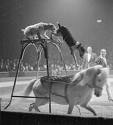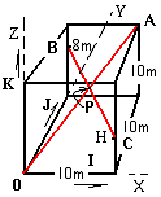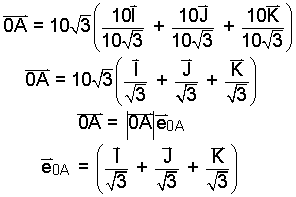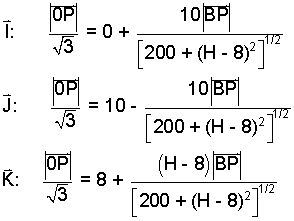| THERMO Spoken Here! ~ J. Pohl © | TOC NEXT ~ 13 |
Dog and Pony Show

After performing jumps onto and off the backs of running ponies, dogs of a traveling circus do feats on wires strung taut on a cubical steel frame. The frame measures ten meters on each edge. Once erected cables are strung variously for specific dogs or tricks.
The sketch below right shows a setup with a walking wire strung from "0" to "A" (vector: 0A). Next a cable BC is attached to the frame at "B" (eight meters above the floor). The other end of the cable, "C", is attached to the opposite vertical post a height of "H" meters from the floor. "H" is chosen such that the crossing cables contact at point, "P." Confirm the height, "H," to be two meters.

♦ A worker who sees the configuration of cables is symmetric, might say correctly, "The height is two meters." But the worker's boss might say, "Never mind symmetry; prove it!" Calculations are needed. Dimensions and a vector basis (I, J, K) are provided with the figure (all distances are meters). Prove the height is two meters.
To begin, for "H" correctly chosen, the following vector equality will be true.
0P = 0B + BP
The above equation is implicit; it implies a truth. Now we use numerical information available to write each term as explicitly as possible. We discuss these vectors one at a time then combine them in the equation.
Since we do not have the components of 0P, we represent it in "magnitude-unit vector" form.
0P = |0P|e0P
For the next vector, 0B, we look at the figure and see its components are known.
0B = 0I + 10J + 8K
BP is not known, write it in magnitude-direction form.
BP = |BP|eBP
Putting these into our equation yields:
|0P|e0P = (0 I + 10 J + 8 K) + |BP|eBP
By a check, our steps are correct. There are four unknown entities in the above equation. By observation of the figure we realize equivalences of unit vectors. Specifically, we have:
e0P = e0A and eBP = eBC
It is apparent e0A (the direction of the vector 0A) can be written. To write that vector, we write 0A, determine its length and finally divide 0A by its length.
0A = 10 I + 10 J + 10 K which has the length (or magnitude), |0A|:
|0A| = [102 + 102 + 102]½ = 10(3)½
To complete this we multiply and divide 0A by its magnitude then arrange it to have e0A. The steps are shown below.
 |
(1)
OA is originally a component form vector. Here, with no steps omitted, the unit vector direction of OA is determined. |
Next we go after eBC which is the direction of vector BC. We use the vector equation,
0B + BC = 0C.
Writing this directly,
(0 I + 10 J + 8 K) + BC = (10 I + 0 J + H K)
which solves for BC and then to yield eBC as:

Returning to the beginning equation, we have:
|0P|e0A = ( 0 I + 10 J + 8 K) + |BP|eBC
So we put the pieces into it.

Vectors are ordered numbers associated with previously prescribed directions. The term, "ordered triple" is used sometimes. The vector procedure is always the same. The next task is to separate the above messy equation (carefully) into components. One way is to successively collect all I, then J and then K pieces left of equality such that their vector sum equals zero. Then, if a vector equals zero, the magnitude of each of its components must equal zero - this produces three scalar equations to solve. A second technique (used here) is to scalar multiply the vector equation successively by I, then J, then K. The result is the same three scalar equations. See below:

The three unknown quantities are |0P|, |BP| and H. Manipulating these equations one obtains:

The apparatus dimensions were chosen symmetric (It's nice to know the answer in advance). Typically there are persons "of wisdom" who see the symmetry and proclaim proudly and correctly, "Two Meters!"
To use symmetry is wonderful when it is there, when you see it and use it correctly. However, symmetry is rare. The vector method is suited to every circumstance. You can program a computer to do vectors but not to see symmetry. Tomorrow the dog trainer wants the wire BC located so the wire, 0A, passes with a "closest distance" between them to be 0.25 meters (the height of her smallest, most-talented dog). And she wants the structure dimensions must to be changed to 8.3m x 13m x 11 m. No problemo (for vectors) as they say. So, just like us, the sharpie will need vectors, patience and work to get an answer. Bon voyage!
High Wire Apparatus

After performing with ponies, the dogs of a traveling show do feats on wire strung on a cubical steel frame. The frame measures ten meters on each edge. Once it is erected cables are strung for specific dogs or tricks. Since the feats of the dogs must move smoothly and promptly, the rigger must have a good knowledge of cable lengths and places of connection. In this example we apply vectors to that task.
Premise presently unwritted!